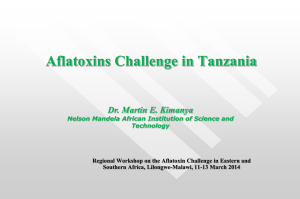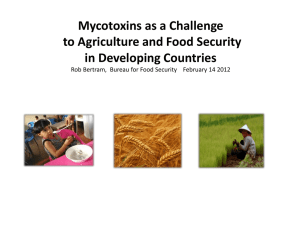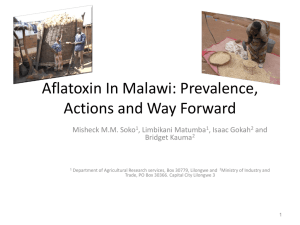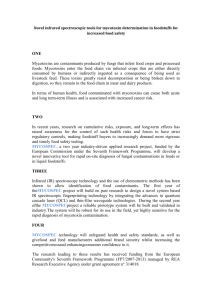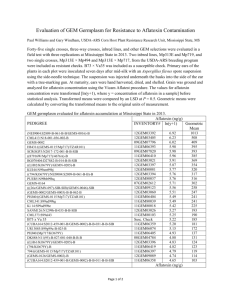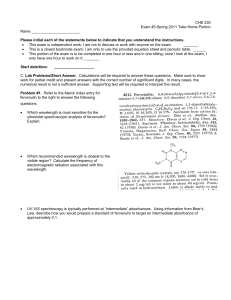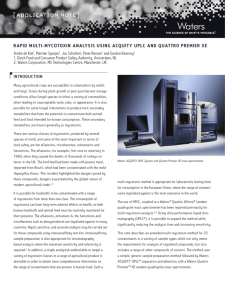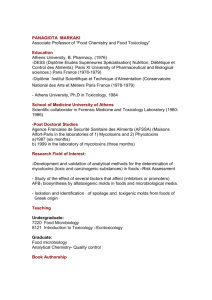Mycotoxin Testing with Aran Gas
advertisement
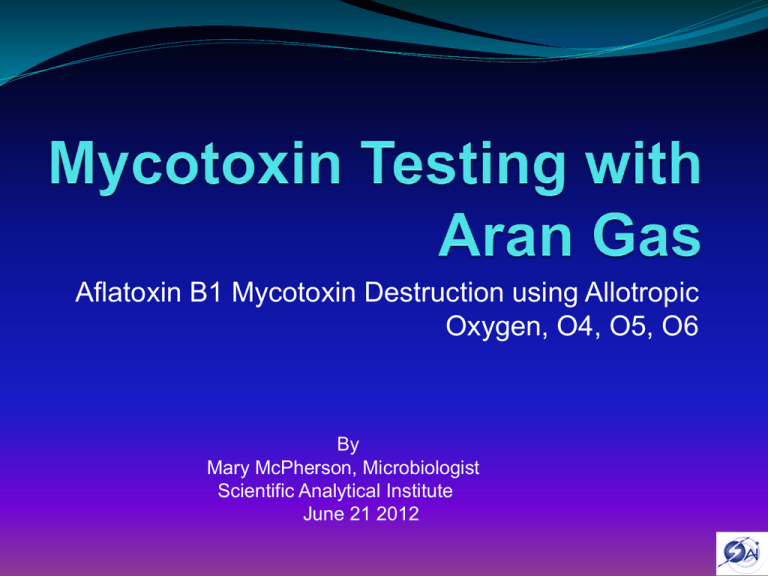
Aflatoxin B1 Mycotoxin Destruction using Allotropic Oxygen, O4, O5, O6 By Mary McPherson, Microbiologist Scientific Analytical Institute June 21 2012 Aran is… Molecular Oxygen Plasma or what we call Polyatomic Oxygen Polymer - “POP” called AranTM Oxygen commonly exists as an O2 molecule. The AranizerTM creates, through energy, higher allotropes of oxygen, O4, O5, O6, O8… These oxygen molecules have oxidizing properties far greater than ozone and a much longer half-life. Thus we have a powerful oxidizer. Reaction 5 molecules of aran to one molecule of mycotoxin will be enough aran to theoretically breakdown the Aflatoxin B1 Theoretical Formulation 5O5 + C17H12O6 CO2 (vapor) + H2O (vapor) Basic theoretical formula Tested Agent 7-18-05 AJ-1 Aflatoxin B1 Aspergillus flavus mycotoxin Chemical Formula C17H12O6 Formula Weight 312.3 The Aflatoxin B1 compound was bought from Sigma Aldrich Company. It is a standard reagent grade mycotoxin, catalog # A6636 neat powder. Aspergillus species capable of producing aflatoxins Species Mycotoxins produced AFB AFG CPA* Major sources Geographical distribution A. flavus + – – All kinds of foods Ubiquitous in warmer latitudes A. parasiticus + + – Peanuts Specific areas A. nomius + + – Bees USA, Thailand A. pseudotamarii + – + Soil Japan A. bombycis + + – Silkworm frass Japan, Indonesia A. ochraceoroseus + – – Soil Africa A. australis + + + Soil, peanuts Southern hemisphere *AFB, B aflatoxins; AFG, G aflatoxins; CPA, cyclopiazonic acid IARC MONOGRAPHS VOLUME 82 Why Common Health Problem – “listing was revised to known to be human carcinogens in the Sixth Annual Report on Carcinogens in 1991.” National Toxicology Program, Department of Health and Human Services This is your liver on mycotoxin Liver Cancer Occurrence in foods cereals, oilseeds, spices and tree nuts, maize, groundnuts (peanuts), pistachios, brazils, chilies, black pepper, dried fruit and figs, milk, nonfat dry milk, cheese, yogurt, peanut butter, eggs, meat, and just about any other food substance that is grown in warm moist climates Farm Related Benefits Field Practices Environmental Farm Contaminant Shipping commodities Storage Contaminant Disease Prevention Still on WHY Chemical Formula - C17H12O6 important because this has benzene ring and bonds that are in many other compounds that the allotropic oxygen can breakdown such as solvents, formaldehyde, and other biological agents. Aflatoxin B1 History Aflatoxins were first identified in England in 1960’s the shorthand of its causative agent: A. fla.10,000 turkeys and ducks died within a few months called Turkey X disease Cause - Aspergillus flavus contamination of peanut meal Previous to this: Khrushchev in 1939 was faced with horses dying on farms all over the western parts of the Ukraine. Khrushchev wrote, ‘‘I can’t believe that science is absolutely helpless here…” ‘‘We had won more than just a victory for our agriculture. It was a moral and political victory as well. But how many collective farm chairmen, cattle raisers, agronomists, animal husbandry specialists, and scientists had lost their heads as saboteurs before I stepped in and took charge of the situation.’’ Korneev (1948) fed white mice with oats infested with Stachybotrys alternans strains According to Gajdusek (1953), cases of human stachybotryotoxicosis have been found mainly in regions where the equine disease has also been reported. Forgacs et al. (1958) studied the toxicity of 40 strains The Role of Stachybotrys in the Phenomenon Known as Sick Building Syndrome EEVA-LIISA HINTIKKA Finnish Institute of Occupational Health Uusimaa Regional Institute of Occupational Health Arinatie 3A, FIN-00370Helsinki, Finland AJ-1 Aranizer Glove Box The final setup is: an unknown portion of Aflatoxin B1 placed in a clean (sterile) 250 mL Erlenmeyer flask. A 100 mL aliquot of distilled water was added to the Erlenmeyer flask. Cup & Tubing Equipment Data AJ-1 Aranizer output 2525 mg/hr Aran gas average molecular weight of O6 previous similar models tested by Campbell and Associates Spectrophotometer 2401 Schimadzu UVProbe 190 nm – 900 nm peak analyses peaking below 190 nm - O4 peaks at 151 nm PK Laboratory Analyzed the series of samples and blanks using HPLC Sampling 2 - Blanks taken from the dilution water not treated 1 aliquot of dilution water was Aranized for comparison 2 - 10 mL aliquots were taken from the original test matrix – labeled “Start Point” NOTE the Aflatoxin did not dissolve well– therefore the sampling was done while the sample was being stirred to ensure well mixed samples After 30 minutes 1 – 10 mL After another 30 minutes 1 – 10 mL sample was taken labeled 60 minutes After another 11 hours 1 – 10 mL sample was taken labeled 12 hours Sampling Schedule Test start time 1:16 AM 80 mL Sample at Sample at Sample at 1:46 AM 70 mL (1:49AM) 2:19 AM 60 mL (2:22 AM) 2:22 PM Last sample Mycotoxin Test Results ng/mL 30000 25000 20000 15000 Mycotoxin Test Results ng/mL 10000 5000 0 Aranization for 30 minutes Mycotoxin Test Results ng/mL 30000 25000 20000 15000 10000 Mycotoxin Test Results ng/mL 5000 0 Aranization for 60 minutes Mycotoxin Test Results ng/mL 30000 25000 20000 15000 Mycotoxin Test Results ng/mL 10000 5000 0 Aranization for 12 hours 30 Minute Aran Treatment Analytical results Chemical Mycotoxins Aflatoxin B1 Time Initial – ½ hr Aran ™ 2525 mL/hr Starting Measurable ng/mL: Ending Measurable ng/mL: 26,000 ng/mL 11,000 ng/mL Reduced amount of “Aflatoxin B1” ng/mL 15,000 ng/mL A reduction of about 58% in 30 minutes time. Mary McPherson 60 minute Aran Treatment Analytical results Chemical Mycotoxins Aflatoxin B1 Time Initial – 1 hour Aran ™ 2525 mL/hr Starting Measurable ng/mL: Ending Measurable ng/mL: 26,000 ng/mL 4,000 ng/mL Reduced amount of “Aflatoxin B1” ng/mL 22,000 ng/mL A reduction of about 85% in 60 minutes time. Mary McPherson 12 hour Aran Treatment Analytical results Chemical Mycotoxins Time Aran ™ Aflatoxin B1 Initial – 12 hr 2525 mL/hr Starting Measurable ng/mL: Ending Measurable ng/mL: 26,000 ng/mL 520 ng/mL Reduced amount of “Aflatoxin B1” ng/mL 25,480 ng/mL A reduction of about 98% in 720 minutes time. Mary McPherson References 1. Source: World of Forensic Science, ©2006 Gale Cengage 2. Herman Schuette Octozone Patent Jan. 12 1943 3. Aflatoxin Handbook USDA March 2002 4. Report on Carcinogens, Twelfth Edition (2011) Aflatoxins CAS No. 1402-68-2 5. Multimolecular Oxygen 2 Dr. Basil Earle Wainwright 2000 6. Molecular Variants of Oxygen Atoms by Basil E. Wainwright 10-23-2000 7. Code of practice for the prevention and reduction of mycotoxin contamination in cereals, including annexes on ochratoxin a, zearalenone,fumonisins, trichothecenes CAC/RCP 51-2003 8. The chemistry and biology of aflatoxin b1: from mutational spectrometry to carcinogenesis Carcinogenesis Vol.22 no.4 pgp. 535-545, 2001 9. Diener et al., 1987 and(Maren A. Klich USDA 2002 10. Vet. Med. – Czech, 46, 2001 (6): 169–174 Potential Hazard of Simultaneous occurence of aflatoxin B1 and ochratoxin A 11. Review of the Toxicology of Aflatoxin by W.H. Butler MRC Toxicology Unit Surrey England 12. African Journal of Biotechnology Vol. 2 (9), pp. 254-263, September 2003 Mycotoxins in food in West Africa: current situation and possibilities of controlling it by S.A. BANKOLE* and A. ADEBANJO Accepted 29 August 2003 13. Identification of common Aspergillus species by Maren A. Klich 14. First OIE/FAO-APHCA Regional Workshop on Feed Safety - Feed borne Disease Prevention (Tokyo, Japan, 12-15 July 2010) 15. Sigma Aldrich 16. Cayman Chemical 17. IMPORTANCE OF AFLATOXINS IN HUMAN AND LIVESTOCK HEALTH Ananth S Bommakanti, and Farid Waliyar. 18. Journal of Applied Sciences Research, 8(2): 719-726, 2012 ISSN 1819-544X Work - Related Airborne Fungi and the Biological Levels of Mycotoxin in Textile Workers by 1Amal Saad-Hussein, 1Safaa Elserougy, 1Safia Beshir, 2Mohamed I.M. Ibrahim, 3Abdel-Hameed Awad, and 2Mosaad A. Abdel-Wahhab, 19. Food Borne Aflatoxin Hazards 20. Worldwide regulations for mycotoxins in food and feed in 2003 21. FDA and USDA materials
